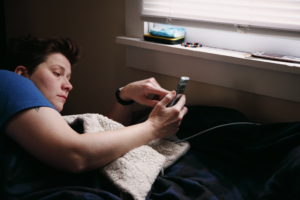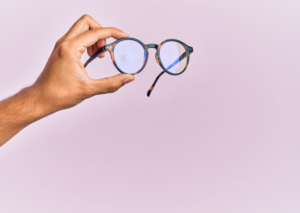In recent years, discussions about blue light have become increasingly prevalent, particularly concerning its impact on our eyes. This has led many to explore various solutions, such as prescription lenses designed to filter out blue light. But what is blue light, and how does it affect our vision and overall health?
This blog delves into the science behind blue light to understand whether it is a friend or foe to our eyes.
What is Blue Light?

Blue light is a high-energy visible (HEV) light with wavelengths ranging from approximately 380 to 500 nanometers. It is a part of the visible light spectrum, which means it is one of the many colors of light that can be seen by the human eye.
Natural vs. Artificial Blue Light
Blue light is naturally emitted by the sun and plays a crucial role in regulating our circadian rhythm, the body’s internal clock that dictates sleep-wake cycles. However, with the advent of digital devices, we are now exposed to artificial blue light from screens on smartphones, computers, tablets, and LED lighting. This increase in exposure has raised concerns about the potential negative effects on our eyes and health.
The Benefits of Blue Light

Before delving into the potential harm, it is important to acknowledge that blue light does have beneficial effects:
Regulating Sleep-Wake Cycles
Natural blue light from the sun helps regulate our circadian rhythm. Exposure to blue light during the day can boost alertness, improve mood, and enhance cognitive function. This is why spending time outdoors during daylight hours can be beneficial for mental and physical health.
Enhancing Visual Clarity
Blue light contributes to sharper, clearer vision. It helps improve color perception and contrast, making it easier to see fine details. This is particularly important for activities that require precision and clarity, such as reading and driving.
The Dark Side of Blue Light

Despite its benefits, excessive exposure to blue light, especially from artificial sources, has been linked to several health concerns.
Digital Eye Strain
One of the most common issues associated with prolonged exposure to blue light is digital eye strain, also known as computer vision syndrome. Symptoms include dry eyes, blurred vision, headaches, and neck and shoulder pain. Staring at screens for extended periods can strain the eye muscles, leading to discomfort and fatigue.
Potential Retinal Damage
There is ongoing research on the potential long-term effects of blue light on retinal health. Some studies suggest that prolonged exposure to high-energy blue light can contribute to retinal damage and increase the risk of age-related macular degeneration (AMD). While the evidence is not conclusive, it raises valid concerns about the cumulative impact of blue light on eye health.
Sleep Disruption
Exposure to artificial blue light, especially in the evening, can interfere with sleep patterns. Blue light suppresses the production of melatonin, the hormone responsible for regulating sleep. This can lead to difficulties falling asleep and reduced sleep quality, ultimately affecting overall health and well-being.
Mitigating the Risks

Given the potential risks associated with blue light, it’s important to take steps to mitigate its impact, particularly for those who spend significant time in front of screens.
Use of Prescription Lenses
One effective way to reduce blue light exposure is by using prescription lenses that incorporate blue light filtering technology. These lenses can help minimize the amount of blue light that reaches the eyes, thereby reducing the risk of digital eye strain and other potential issues. They are particularly beneficial for individuals who require vision correction and spend a lot of time on digital devices.
Screen Time Management
Managing screen time is crucial in minimizing blue light exposure. The 20-20-20 rule is a simple yet effective strategy: every 20 minutes, take a 20-second break and look at something 20 feet away. This helps reduce eye strain and allows the eyes to relax.
Adjusting Device Settings
Many digital devices now come with built-in blue light filters or “night mode” settings. These features reduce the amount of blue light emitted by the screen, making it easier on the eyes, especially during evening hours. Adjusting screen brightness and contrast can also help alleviate eye strain.
Ambient Lighting
Proper lighting in your environment can make a significant difference. Using warmer, dimmer lights in the evening can help reduce blue light exposure. Additionally, minimizing glare on screens by adjusting the position of devices and using anti-glare screen protectors can also help.
The Future of Blue Light Research
Research on blue light is ongoing, and our understanding of its effects continues to evolve. As technology advances, we can expect to see more innovations aimed at mitigating the negative impacts of blue light while maximizing its benefits. This includes the development of more advanced blue light filtering technologies in prescription lenses and digital devices.
Personalized Solutions
Future advancements may lead to more personalized solutions for blue light exposure. For instance, customized lenses that cater to an individual’s specific needs and lifestyle could become more widely available. Additionally, further research may provide clearer guidelines on safe exposure levels and more effective ways to protect our eyes.
Final Thoughts
The relationship between blue light and eye health is complex, encompassing both beneficial and potentially harmful effects. While natural blue light plays a crucial role in regulating our sleep-wake cycles and enhancing visual clarity, excessive exposure to artificial blue light from digital devices can lead to digital eye strain, potential retinal damage, and sleep disruption. Taking proactive steps, such as using prescription lenses with blue light filtering technology, managing screen time, adjusting device settings, and optimizing ambient lighting, can help mitigate the risks associated with blue light exposure.
Protect Your Eyes with High Quality Blue Light Filtering Prescription Lenses from SpecialEyes
Trust SpecialEyes for custom prescription lenses in Langley! Explore men’s eyeglass frames, stylish women’s eyeglasses, and men’s prescription sunglasses online. Their expansive range of eyewear also includes high-quality progressive lenses and polarized sunglasses for driving. Shop prescription eyeglasses and lenses online today. Visit their website now to start exploring.

